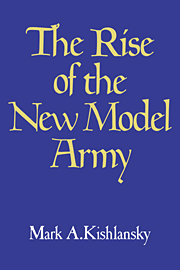1 - The Parliamentary Cause
Published online by Cambridge University Press: 17 September 2009
Summary
The Lords and Commons in this present Parliament assembled according to the duty and trust which lies upon them, for prevention of these great mischiefs and preservation of the safety of His Majesty's person, the peace of the Kingdom and the defense of the Parliament resolved and ordained that an Army be forthwith raised.
From Civil War to Revolution – the progression is unmistakable. Fundamental authority, first in the person of the King and then in the institution of Parliament, was under attack. The King's power eroded slowly over decades, victim of both long-term forces and of his own policies and personality. Parliamentary legitimacy collapsed spectacularly in the year between the end of the war and the Army's march to London. It too gave way before a combination of factors not all of its own making. Royal defeat and parliamentary collapse were the antecedents to military rule. The images of change are vivid: Charles defiantly raising his standard at Nottingham; fleeing to Newcastle in the guise of a servant; seized unceremoniously by Cornet Joyce; and finally executed in the name of the people. The Houses of Parliament successively violated: by the King in search of the five members; by the mob of apprentices forcing Lords and Commons to recall their votes; by Colonel Pride's clumsy purge; and by Cromwell's file of musketeers, who neatly dissolved the Rump.
- Type
- Chapter
- Information
- The Rise of the New Model Army , pp. 3 - 25Publisher: Cambridge University PressPrint publication year: 1980



